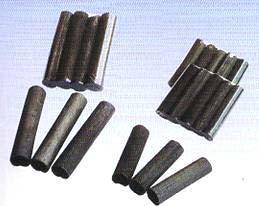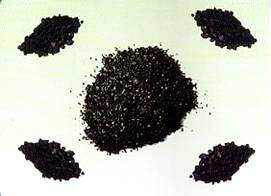|
Related
Products
| |

 Bamboo round charcoal stick
Bamboo particle charcoal
Bamboo round charcoal stick
Bamboo particle charcoal
Similar to wood charcoal, bamboo charcoal is a micro-porous material with
excellent adsorption property for its large specific surface area. Adsorption
of bamboo charcoal is theoretically classified into physical adsorption and
chemical adsorption. Physical adsorption is caused by molecule acting force
(van der Waals force) between adsorbent and adsorbate that doesn�t change the
surface composition of adsorbent and the situation of the molecule of
adsorbate. Chemical adsorption is by chemical bond between adsorbent and
adsorbate in which the exchange and transference of electrons happen to result
in rearrange of atoms and chemical bond formation or destroying.
Physical adsorption goes fast and is reversible. It usually
carries through in lower temperature without selection and acts in monolayer
or multilayer because there is van der Waals force on one layer of molecule of
adsobate. Similar to chemical action, chemical adsorption needs activation
energy. It is not reversible and usually carries through in higher temperature
companying chemical output. It is always monolayer adsorption with distinct
selection.
The electric conductivity of bamboo charcoal will be
reinforced with the rising of terminal pyrolysis temperature. When terminal
pyrolysis temperature reaches 700℃,
the resistance in bamboo charcoal becomes very small, only 5.40�10-6
Ω ﹒M, meaning
good conductivity. Therefore, bamboo charcoal carbonized under high
temperature has effective property for shielding electromagnetism. As the
industrialization worldwide speeds up, air pollution and water pollution are
becoming serious environmental problems. Bamboo charcoal is functional
material for environment protection and developed fast in recent years for the
reasons that
-
the wood that can be used as high-grade charcoal reduced
rapidly and almost exhausted;
-
the harvest cycle of bamboo is short because it grows very
fast. As a result, making bamboo charcoal doesn't destroy forest and
environment;
-
bamboo charcoal are similar in properties to and can replace
the high quality wood charcoal made from hardwood;
-
bamboo charcoal is good in strength and easy to process into
different shapes.
At present, a series of bamboo charcoal products have been
manufactured by taking advantage of the excellent adsorption and infrared
radiation. These products involve in a variety of fields such as purifying
drinking water and indoor air, adjusting humid in house, health care, odor
adsorption, bamboo charcoal arts and so on. Some of products with shielding
electromagnetism and anti-radiation are in research.
Utilization of bamboo charcoal
Because of a lot of pores and high specific surface area,
bamboo charcoal has strong adsorption capacity. Meanwhile, its physical and
chemical properties are very stable. It isn�t soluble in water and other
solvents. It demonstrates high stability in various working conditions except
with strong oxidant in high temperature, for example, oxygen in high
temperature, ozone, chlorine and salt of dichromate. So bamboo charcoal can be
used both in a wide range of pH and in many solvents. Moreover, it can be used
in the circumstances with high pressure and high temperature.
The use of bamboo charcoal indoor
Main sources of indoor air pollution, Due to the development of economic and improvement of society,
more and more activities of human being such as work, study and entertainment
are often performed indoor. But indoor environment is relatively closed and
the air is polluted. The main sources of indoor pollution are indoor
decoration, human bodies and oil-smoke in kitchen.
(1) Indoor decoration
People are investing more and more money into indoor
decoration to improve living environment. Meanwhile, tremendous wood panels
and decorative stones are placed into houses. This means some harmful
substances such as formaldehyde, ammonia, benzene etc mixing in indoor air. If
the decorative products are of bad quality, the air pollution indoor might
exceed the state standard regarding indoor decoration.
Formaldehyde is a colorless, gaseous compound used to make
glue due to its adhesive and a certain pesticide and antiseptic capacity.
Gaseous formaldehyde has strong stimulation to people. It comes from
wood-based panels, plastic and furniture when a house has just decorated. The
results of studies demonstrate that when indoor formaldehyde content is 0.1
mg/m 3 people feel odor and
uncomfortable; when it is 0.5mg/m3,
people will be stimulated to tear, when it reaches 0.6mg/ m3,
the throat of people will be uncomfortable or irritated; with higher content,
it can cause illness, emesis, cough, suffocation and emphysema pulmonary. When
formaldehyde content in air is 30mg/m3,
it can cause death. People contacted with lower dose formaldehyde for long
time, might suffer from chronic respiratory diseases, illnesses of female, bad
newly born babies, chromosomal anomaly, even a nasopharyngeal cancer. To
control indoor formaldehyde polluting, besides selecting good material for
decoration, and ventilating house, we can use bamboo charcoal for its good
adsorption because formaldehyde�s releasing period ranges from 3 to 15 years.
Ammonia in house comes from cement antifreeze additive.
Ammonia stimulates eyes and breathing channel.
Painting and coating give out benzene and so on, which are
harmful to blood forming organ of human body. At the beginning of touching
benzene, persons show the symptoms of leukocyte continuous decrease and
dizziness, but a person might suffer from cancer if he contacts with it for a
long time.
(2). Human body
Human being respires air that is exchanged in lung, from it
carbon dioxide and other harmful substances are exhaled. Study results show
that people excrete beyond 20 harmful substances by breathing, sweating
urinating and defecating. So people often feel dizziness, difficulty in
breath, even suffocation, illness in a crowded unventilated house.
The smog smokers give out is also an important source of
indoor air pollution. Active ingredients of tobacco are decomposed at high
temperature, and sometime they also form new chemical substances. It is
demonstrated that there are tens of substances harmful to human body by
analyzing the components in smog. For example, carbonic oxide, ammonia,
formaldehyde, benzopyrene, nicotine, tar etc are found in smog. These are
severely harmful to human organ.
(3). Oil-smoke in kitchen
Burning LPG that residents use daily consumes oxygen and gives
out carbonic oxide, carbon dioxide, nitrogen oxide, aldehyde, benzopyrene and
so on. Vegetable oil gives out volatilizing chemical compounds (for example:
acrylic acid) when it is heated at high temperature. These chemical compounds
diffuse indoor and are harmful to human body.
Preventing indoor air pollution
There are two kinds of ways for improving indoor air. The
first is to use environment friendly material. The second is to use indoor
deodorizer correctly. Research results demonstrate that bamboo charcoal is a
good product of indoor deodorizer because of good adsorption, long effective
period to indoor harmful material and being regenerative and reusable easily.
If product of bamboo charcoal is modified, its effect will be better.
The use of bamboo charcoal in purifying water
All knows the seriousness of water pollution. To protect
environment, it is an important task to dispose wasted water and drinking
water.
Bamboo charcoal adsorbs 2,4-dichloro-hydroxybenzene
Conclusions
(1) Bamboo charcoal has good capability for absorbing
2,4-di-chloro hydroxybenzene from water, whose reaction abide by the first
order reaction kinetics.
(2) Under this test conditions, the maximum amount of
2,4-di-chloro hydroxybenzene absorbed by bamboo charcoal reaches 1500mg/L
(3) The adsorption properties of bamboo charcoal on
2,4-di-chloro hydroxybenzene are closely related with size of bamboo charcoal
particle, specific surface area, and adsorption temperature.
(4) When the acid
value is at range of 2~10, bamboo charcoal has good properties on absorbing
2,4-di-chloro hydroxybenzene.
The use of bamboo charcoal in cooking and boiling Bamboo charcoal not
only eliminates harmful substances such as surplus chlorine, chloroform etc.,
but also contains rich natural mineral, for example, potassium, magnesium,
sodium, calcium etc. Study result shows that if bamboo charcoal is dipped in
water, metal ion can be dissolved out. (Table4). So water quality can be
improved when bamboo charcoal is used in cooking and boiling.
Use of bamboo charcoal in adjusting humidity
Because bamboo charcoal is activated under the condition of
very little oxygen and high temperature, it contains almost no water and has a
lot of pores. This makes its high effectiveness in adjusting humidity. When
humidity of surroundings overtakes that of bamboo charcoal, bamboo charcoal
can adsorb mass of moisture from air. When humidity of surroundings becomes
lower than that of bamboo charcoal, it can give out moisture into air to keep
a dynamic equilibrium. So bamboo charcoal is usually used to make different
health care products for adjusting micro-surroundings of human beings. In
practice, bamboo charcoal is usually laid under indoor floor or placed behind
wallboards.
Using the emitting infrared ray property of bamboo charcoal
Because of the nature of emitting infrared ray, bamboo
charcoal can be used in health care. Massaging bodies with bamboo charcoal is
favorable to promote blood flowing. Putting it into oil not only can fry
delicate food but also can prevent the oxidization of oil. Sinking bamboo
charcoal into a piscine before bathing, when water temperature rises, the
wavelength of bamboo charcoal will become short and the quantity of heat it
absorbed will enlarge. So persons absorb the infrared ray coming from the
bamboo charcoal to warm themselves.
Use of bamboo charcoal in deodorant and preservative
We introduce a line of bamboo
charcoal product for various application at home and business. Our
bamboo charcoal for closet is great to
absorb the odor and keep the closet or any room fresh, regulates humidity. Pet
health and odor is always a concern with the pet owner, our
bamboo charcoal padding for pet will
definitely reduce the odor and also help to improve your pet health. Refrigerators are used to store fresh foods. Their capacities
are so big that they store almost all kinds of food ranged from crude food to
ripened food: vegetable, fruit, fresh fish, meat and so on. Although
refrigerators are designed considerately, for example, it has many
departments, but it is not able to exclude mixed odor because of the cold air
flowing. We use our bamboo charcoal for
fridge to keep content in a refrigerator fresh. . At the same time, because of bamboo charcoal�s effect of adjusting
humidity, it can prolong the preservative period of vegetable and fruit.
Moreover, bamboo charcoal can be reused after washing and sunning.
|
![]()
![]()







